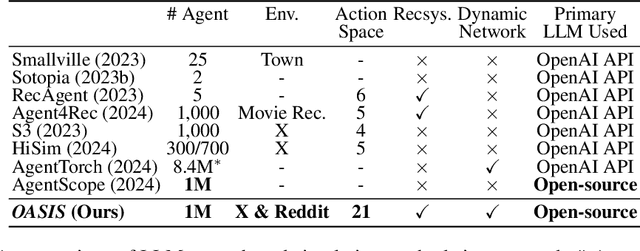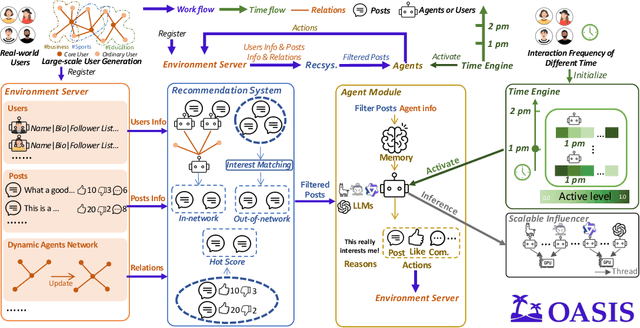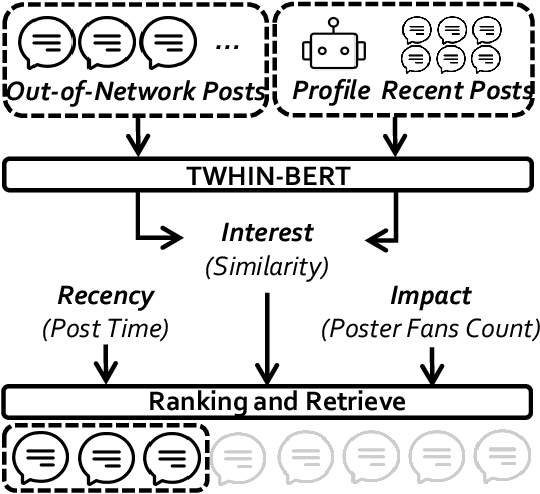Jinsong Chen
DAM-GT: Dual Positional Encoding-Based Attention Masking Graph Transformer for Node Classification
May 23, 2025Abstract:Neighborhood-aware tokenized graph Transformers have recently shown great potential for node classification tasks. Despite their effectiveness, our in-depth analysis of neighborhood tokens reveals two critical limitations in the existing paradigm. First, current neighborhood token generation methods fail to adequately capture attribute correlations within a neighborhood. Second, the conventional self-attention mechanism suffers from attention diversion when processing neighborhood tokens, where high-hop neighborhoods receive disproportionate focus, severely disrupting information interactions between the target node and its neighborhood tokens. To address these challenges, we propose DAM-GT, Dual positional encoding-based Attention Masking graph Transformer. DAM-GT introduces a novel dual positional encoding scheme that incorporates attribute-aware encoding via an attribute clustering strategy, effectively preserving node correlations in both topological and attribute spaces. In addition, DAM-GT formulates a new attention mechanism with a simple yet effective masking strategy to guide interactions between target nodes and their neighborhood tokens, overcoming the issue of attention diversion. Extensive experiments on various graphs with different homophily levels as well as different scales demonstrate that DAM-GT consistently outperforms state-of-the-art methods in node classification tasks.
Diffusion Augmented Complex Maximum Total Correntropy Algorithm for Power System Frequency Estimation
Apr 10, 2025Abstract:Currently, adaptive filtering algorithms have been widely applied in frequency estimation for power systems. However, research on diffusion tasks remains insufficient. Existing diffusion adaptive frequency estimation algorithms exhibit certain limitations in handling input noise and lack robustness against impulsive noise. Moreover, traditional adaptive filtering algorithms designed based on the strictly-linear (SL) model fail to effectively address frequency estimation challenges in unbalanced three-phase power systems. To address these issues, this letter proposes an improved diffusion augmented complex maximum total correntropy (DAMTCC) algorithm based on the widely linear (WL) model. The proposed algorithm not only significantly enhances the capability to handle input noise but also demonstrates superior robustness to impulsive noise. Furthermore, it successfully resolves the critical challenge of frequency estimation in unbalanced three-phase power systems, offering an efficient and reliable solution for diffusion power system frequency estimation. Finally, we analyze the stability of the algorithm and computer simulations verify the excellent performance of the algorithm.
Mixture of Decoupled Message Passing Experts with Entropy Constraint for General Node Classification
Feb 12, 2025Abstract:The varying degrees of homophily and heterophily in real-world graphs persistently constrain the universality of graph neural networks (GNNs) for node classification. Adopting a data-centric perspective, this work reveals an inherent preference of different graphs towards distinct message encoding schemes: homophilous graphs favor local propagation, while heterophilous graphs exhibit preference for flexible combinations of propagation and transformation. To address this, we propose GNNMoE, a universal node classification framework based on the Mixture-of-Experts (MoE) mechanism. The framework first constructs diverse message-passing experts through recombination of fine-grained encoding operators, then designs soft and hard gating layers to allocate the most suitable expert networks for each node's representation learning, thereby enhancing both model expressiveness and adaptability to diverse graphs. Furthermore, considering that soft gating might introduce encoding noise in homophilous scenarios, we introduce an entropy constraint to guide sharpening of soft gates, achieving organic integration of weighted combination and Top-K selection. Extensive experiments demonstrate that GNNMoE significantly outperforms mainstream GNNs, heterophilous GNNs, and graph transformers in both node classification performance and universality across diverse graph datasets.
Rethinking Tokenized Graph Transformers for Node Classification
Feb 12, 2025Abstract:Node tokenized graph Transformers (GTs) have shown promising performance in node classification. The generation of token sequences is the key module in existing tokenized GTs which transforms the input graph into token sequences, facilitating the node representation learning via Transformer. In this paper, we observe that the generations of token sequences in existing GTs only focus on the first-order neighbors on the constructed similarity graphs, which leads to the limited usage of nodes to generate diverse token sequences, further restricting the potential of tokenized GTs for node classification. To this end, we propose a new method termed SwapGT. SwapGT first introduces a novel token swapping operation based on the characteristics of token sequences that fully leverages the semantic relevance of nodes to generate more informative token sequences. Then, SwapGT leverages a Transformer-based backbone to learn node representations from the generated token sequences. Moreover, SwapGT develops a center alignment loss to constrain the representation learning from multiple token sequences, further enhancing the model performance. Extensive empirical results on various datasets showcase the superiority of SwapGT for node classification.
OASIS: Open Agent Social Interaction Simulations with One Million Agents
Nov 26, 2024



Abstract:There has been a growing interest in enhancing rule-based agent-based models (ABMs) for social media platforms (i.e., X, Reddit) with more realistic large language model (LLM) agents, thereby allowing for a more nuanced study of complex systems. As a result, several LLM-based ABMs have been proposed in the past year. While they hold promise, each simulator is specifically designed to study a particular scenario, making it time-consuming and resource-intensive to explore other phenomena using the same ABM. Additionally, these models simulate only a limited number of agents, whereas real-world social media platforms involve millions of users. To this end, we propose OASIS, a generalizable and scalable social media simulator. OASIS is designed based on real-world social media platforms, incorporating dynamically updated environments (i.e., dynamic social networks and post information), diverse action spaces (i.e., following, commenting), and recommendation systems (i.e., interest-based and hot-score-based). Additionally, OASIS supports large-scale user simulations, capable of modeling up to one million users. With these features, OASIS can be easily extended to different social media platforms to study large-scale group phenomena and behaviors. We replicate various social phenomena, including information spreading, group polarization, and herd effects across X and Reddit platforms. Moreover, we provide observations of social phenomena at different agent group scales. We observe that the larger agent group scale leads to more enhanced group dynamics and more diverse and helpful agents' opinions. These findings demonstrate OASIS's potential as a powerful tool for studying complex systems in digital environments.
OASIS: Open Agents Social Interaction Simulations on One Million Agents
Nov 21, 2024



Abstract:There has been a growing interest in enhancing rule-based agent-based models (ABMs) for social media platforms (i.e., X, Reddit) with more realistic large language model (LLM) agents, thereby allowing for a more nuanced study of complex systems. As a result, several LLM-based ABMs have been proposed in the past year. While they hold promise, each simulator is specifically designed to study a particular scenario, making it time-consuming and resource-intensive to explore other phenomena using the same ABM. Additionally, these models simulate only a limited number of agents, whereas real-world social media platforms involve millions of users. To this end, we propose OASIS, a generalizable and scalable social media simulator. OASIS is designed based on real-world social media platforms, incorporating dynamically updated environments (i.e., dynamic social networks and post information), diverse action spaces (i.e., following, commenting), and recommendation systems (i.e., interest-based and hot-score-based). Additionally, OASIS supports large-scale user simulations, capable of modeling up to one million users. With these features, OASIS can be easily extended to different social media platforms to study large-scale group phenomena and behaviors. We replicate various social phenomena, including information spreading, group polarization, and herd effects across X and Reddit platforms. Moreover, we provide observations of social phenomena at different agent group scales. We observe that the larger agent group scale leads to more enhanced group dynamics and more diverse and helpful agents' opinions. These findings demonstrate OASIS's potential as a powerful tool for studying complex systems in digital environments.
NTFormer: A Composite Node Tokenized Graph Transformer for Node Classification
Jun 27, 2024Abstract:Recently, the emerging graph Transformers have made significant advancements for node classification on graphs. In most graph Transformers, a crucial step involves transforming the input graph into token sequences as the model input, enabling Transformer to effectively learn the node representations. However, we observe that existing methods only express partial graph information of nodes through single-type token generation. Consequently, they require tailored strategies to encode additional graph-specific features into the Transformer to ensure the quality of node representation learning, limiting the model flexibility to handle diverse graphs. To this end, we propose a new graph Transformer called NTFormer to address this issue. NTFormer introduces a novel token generator called Node2Par, which constructs various token sequences using different token elements for each node. This flexibility allows Node2Par to generate valuable token sequences from different perspectives, ensuring comprehensive expression of rich graph features. Benefiting from the merits of Node2Par, NTFormer only leverages a Transformer-based backbone without graph-specific modifications to learn node representations, eliminating the need for graph-specific modifications. Extensive experiments conducted on various benchmark datasets containing homophily and heterophily graphs with different scales demonstrate the superiority of NTFormer over representative graph Transformers and graph neural networks for node classification.
Leveraging Contrastive Learning for Enhanced Node Representations in Tokenized Graph Transformers
Jun 27, 2024Abstract:While tokenized graph Transformers have demonstrated strong performance in node classification tasks, their reliance on a limited subset of nodes with high similarity scores for constructing token sequences overlooks valuable information from other nodes, hindering their ability to fully harness graph information for learning optimal node representations. To address this limitation, we propose a novel graph Transformer called GCFormer. Unlike previous approaches, GCFormer develops a hybrid token generator to create two types of token sequences, positive and negative, to capture diverse graph information. And a tailored Transformer-based backbone is adopted to learn meaningful node representations from these generated token sequences. Additionally, GCFormer introduces contrastive learning to extract valuable information from both positive and negative token sequences, enhancing the quality of learned node representations. Extensive experimental results across various datasets, including homophily and heterophily graphs, demonstrate the superiority of GCFormer in node classification, when compared to representative graph neural networks (GNNs) and graph Transformers.
Diversified Node Sampling based Hierarchical Transformer Pooling for Graph Representation Learning
Oct 31, 2023



Abstract:Graph pooling methods have been widely used on downsampling graphs, achieving impressive results on multiple graph-level tasks like graph classification and graph generation. An important line called node dropping pooling aims at exploiting learnable scoring functions to drop nodes with comparatively lower significance scores. However, existing node dropping methods suffer from two limitations: (1) for each pooled node, these models struggle to capture long-range dependencies since they mainly take GNNs as the backbones; (2) pooling only the highest-scoring nodes tends to preserve similar nodes, thus discarding the affluent information of low-scoring nodes. To address these issues, we propose a Graph Transformer Pooling method termed GTPool, which introduces Transformer to node dropping pooling to efficiently capture long-range pairwise interactions and meanwhile sample nodes diversely. Specifically, we design a scoring module based on the self-attention mechanism that takes both global context and local context into consideration, measuring the importance of nodes more comprehensively. GTPool further utilizes a diversified sampling method named Roulette Wheel Sampling (RWS) that is able to flexibly preserve nodes across different scoring intervals instead of only higher scoring nodes. In this way, GTPool could effectively obtain long-range information and select more representative nodes. Extensive experiments on 11 benchmark datasets demonstrate the superiority of GTPool over existing popular graph pooling methods.
SignGT: Signed Attention-based Graph Transformer for Graph Representation Learning
Oct 17, 2023Abstract:The emerging graph Transformers have achieved impressive performance for graph representation learning over graph neural networks (GNNs). In this work, we regard the self-attention mechanism, the core module of graph Transformers, as a two-step aggregation operation on a fully connected graph. Due to the property of generating positive attention values, the self-attention mechanism is equal to conducting a smooth operation on all nodes, preserving the low-frequency information. However, only capturing the low-frequency information is inefficient in learning complex relations of nodes on diverse graphs, such as heterophily graphs where the high-frequency information is crucial. To this end, we propose a Signed Attention-based Graph Transformer (SignGT) to adaptively capture various frequency information from the graphs. Specifically, SignGT develops a new signed self-attention mechanism (SignSA) that produces signed attention values according to the semantic relevance of node pairs. Hence, the diverse frequency information between different node pairs could be carefully preserved. Besides, SignGT proposes a structure-aware feed-forward network (SFFN) that introduces the neighborhood bias to preserve the local topology information. In this way, SignGT could learn informative node representations from both long-range dependencies and local topology information. Extensive empirical results on both node-level and graph-level tasks indicate the superiority of SignGT against state-of-the-art graph Transformers as well as advanced GNNs.
 Add to Chrome
Add to Chrome Add to Firefox
Add to Firefox Add to Edge
Add to Edge